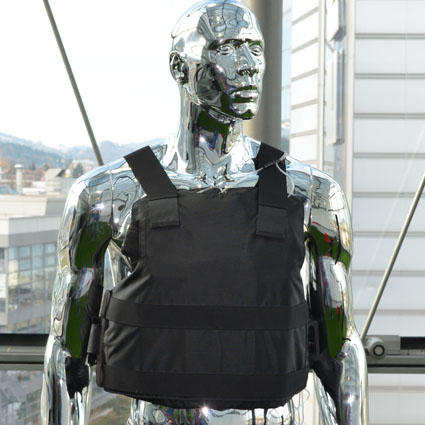| |
| The ballistic vest to be worn under the uniform shirt with integrated "air conditioning unit", for use by police personnel, for example. |
| |
| Functional sportswear is taken for granted nowadays. It is quite unexceptional for a sports jacket, for instance, to be both waterproof and breathable. In the case of working clothes, the functionality is mostly restricted to personal protection against fire, sharp objects, chemicals and so on, with wearer comfort (mostly) not being significance top priority. Bullet-proof vests made of Kevlar, as their name suggests, hold off bullets but they are also impenetrable for water vapor. Thus police personnel who must wear such gear under their uniforms sweat profusely when the weather is warm. A situation that is merely uncomfortable when working in the office negatively affects the physical performance of police officers on duty. |
| |
|
| |
| | | The bullet-proof vest is cooled by a water-filled Coolpad and a mini fan, which blows air through the ventilation layer – ensuring that the wearer remains comfortable. |
| |
|
| |
| Empa has, therefore, together with its industrial partners, developed a «smart» protective vest with an integrated cooling system based on the Coolpad technology, originally designed for use in cooling garments for medical applications. The Coolpads built into the vest are filled with water, which is allowed to evaporate through the membrane, cooling down its surroundings. A mini fan blows air though a fabric spacer behind the pad, providing further cooling. |
| |
| Integrating such an A/C into a garment proved to be quite tricky. It required a novel fabric spacer, which was stable under pressure yet also flexible and soft to the touch, and which offered very little resistance to air flow. A suitable spacer was developed together with Swiss textile manufacturer Eschler. Likewise, there were no fans on the market, which were small enough to be built into the vest; so Empa engineers designed a miniaturized version themselves. Two units including batteries and control electronics now provide the cooling air circulation in the vest. Similarly, the cool pads used till then proved unsatisfactory – since in the protective vest they were mechanically quite stressed they frequently leaked water. A new technique for welding the ultra-thin pad membranes using diode lasers proved to be much more reliable than the conventional method, with the seam remaining soft and flexible. In addition the Empa specialists were able to increase the evaporation rate and therefore the cooling ability. |
| |
|
| |
| | | A multilayer system provides active cooling, including ventilation through the fabric spacer. |
| |
|
| |
| But that wasn't all. In order to simplify refilling the cool pads with water they developed a portable filling station that can be attached to the vest with a quick-release fastener. During the same «pit stop», the mini fans can be exchanged for those with freshly charged batteries. Then the vest is ready once again for three to four hours of duty. |
| |
| Comparative measurements show that the new vest is significantly lighter and also cools much better than systems currently on the market. And in practical use, too, the vest has proven its worth. Staff of the Zürich City police force tested the vest over several warm summer days and gave the new innovation the thumbs up. The first small series of the novel under-uniform protective vest will be produced in the near future by project partner Unico swiss tex GmbH. The «smart» cooling technology is, however, also suitable for protective suits worn over normal clothing, uniform jackets, camouflage suits and even for rucksacks. Developments along these lines are already in progress. |
| |
| |



